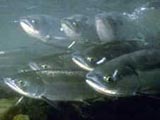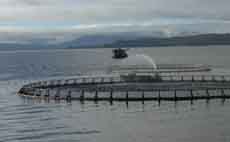So what's wrong with fish?
by David Ogilvie
Fish Farming
Fish farming was developed to help alleviate the depletion of wild marine life from overfishing. While aquaculture may be an option for the rearing of some species of fish, there are inherent problems:
Fish farms pollute
 |
Some fish farms raise fish in floating net-pens -- basically, the marine equivalent of 'factory farms'. The intense accumulation of fish wastes and uneaten feed from these operations can spoil the local marine environment and spread disease to wild fish stocks. The wastes also generate bacteria that consume oxygen vital to shellfish and other bottom-dwelling sea creatures.
In addition to natural wastes, there are also antibiotics (more are given to farmed fish than any other livestock by weight) and other drugs that can harm nearshore ecosystems.
|
Antibiotics have created resistant strains of disease that infect both wild and farmed fish. Pesticides given to the fish (e.g. to control sea lice) and toxic copper sulfate used to keep nets free of algae also build up in sea-floor sediments. Daniel Pauly, Professor of Fisheries at the University of British Columbia in Vancouver says "They're like floating pig farms… They consume a tremendous amount of highly concentrated protein pellets and they make a terrific mess."
Farmed fish are not healthy
As well as harming marine ecosystems, the antibiotics, drugs and other chemicals used in fish farming can compromise human health.
In the wild, salmon get a rich, pink hue by absorbing carotenoid from the pink krill they eat, while farmed fish are given a synthetic pigment called canthaxanthin in their feed. Without it, their flesh would be an unappetising, pale grey.
 |
The pharmaceutical company that distributes its trademarked SalmoFan pigment has swatches similar to paint stores, so fish farmers can choose among various shades. European authorities are suspicious of canthaxanthin, which was linked to retinal damage in people when taken as a sunless tanning pill.
|
Scientists in the United States are far more concerned about two preliminary studies, one in British Columbia and one in Great Britain, that showed farmed salmon accumulate more cancer-causing PCBs and toxic dioxins than wild salmon. The cause appears to be the salmon feed, which contains higher concentrations of fish oil - extracted from sardines, anchovies and other ground-up fish - than wild salmon normally consume. Environmental pollutants, including PCBs and dioxins, make their way into the ocean and are absorbed by marine life. The pollutants accumulate in fat that is distilled into the concentrated fish oil.
Farmed fish aren't cheap

|
The price per kilogram may seem cheaper, but globally speaking, farmed fish is anything but cheap. The fact is farmed fish represent an overall net loss of protein. According to Rosamond Naylor, an agricultural economist at Stanford's Center for Environmental Science and Policy, it takes about 2.4 kilograms of wild fish to produce one kilogram of farmed salmon.
"We are not taking strain off wild fisheries. We are adding to it," Naylor says. "This cannot be sustained forever." Factor in the energy expended to catch, process and transport that fishmeal, and "cheap" farmed fish suddenly seem absurdly costly. |
Farmed fish can escape
When net pens are damaged (e.g. by storms or seals) there can be large releases of farmed fish. Some species of farmed fish do not naturally occur in the area in which they are farmed, and escapees pose a problem as they may ultimately compete with and displace precarious native stocks. Biologists fear these invaders will out-compete the native stocks, hastening their demise.
Fish farms spread disease
Disease and parasites, which would normally exist in relatively low levels in fish scattered around the oceans, can run rampant in densely packed fish farms. Clouds of sea lice, incubated by captive fish on farms, can swarm wild salmon as they swim past on their migration to the ocean.
Alexandra Morton, an independent biologist and critic of salmon farms, began examining sea lice in 2001 when a fishermen brought her two baby pink salmon covered with them. Collecting more than 700 baby pink salmon around farms she found that 78% were covered with a fatal load of sea lice, which burrow into fish and feed on skin, mucous and blood. Juvenile salmon she netted farther from the farms were largely lice-free.
Canadian commercial fishermen, initially supportive of salmon farms, have grown increasingly hostile. They were stunned last August when their nets came up nearly empty during the first day of the wild pink salmon season in the Broughton Archipelago at the northeast end of Vancouver Island. "There should have been millions of pinks, but there were fewer than anyone can remember," said Calvin Siider, a salmon gill-netter. "We can't prove that sea lice caused it. But common sense tells you something, if they are covered by sea lice as babies, and they don't come back as adults."
Salmon farmers point out that the sea lice exist in the wild. Their captive fish are unlikely hosts, they say, because at the first sign of an outbreak, they add the pesticide emamectin benzoate to the feed.
Another recent problem has been hematopoietic necrosis, an infectious virus that attacks the kidneys and spleen of fish. More than a dozen farms in British Columbia have been stricken. Jeanine Siemens, manager of a stolt farm, says, "It was really hard for me and the crew" to oversee the killing of 900,000 young salmon last August because of a viral outbreak. "We had a boat pumping dead fish every day," she said. "It took a couple of weeks. But it was the best decision. You are at risk of infecting other farms."
Frankenfish
It seems things will get worse before they get better. Recently, the prospect of genetically modified salmon that can grow six times faster than normal fish has heightened anxiety. Aqua Bounty Farms Inc., of Waltham, Massachusetts, is seeking US and Canadian approval to alter genes to produce a growth hormone that could take a year off the usual 2 & 1/2 to 3 years it takes to raise a market-size fish. Commercial fishermen and other critics fear that these "frankenfish" will escape and pose an even greater danger to native species than do the Atlantic salmon. "Nobody can predict just what that means for our wild salmon," Alaska Governor Tony Knowles said. "We do see it as a threat." |

